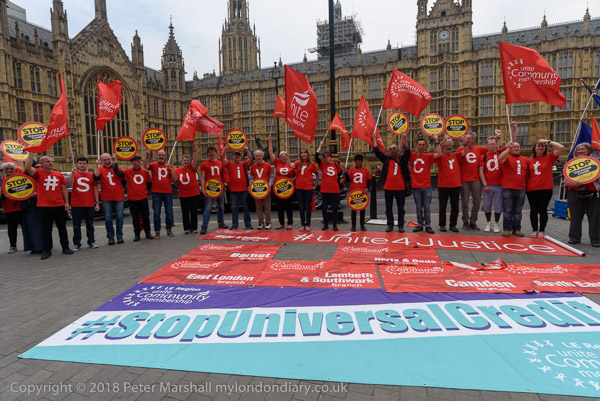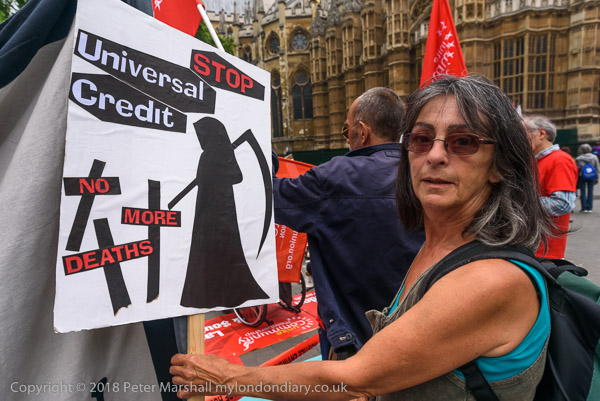
Those t-shirts reading ‘#STOPUNIVERSALCREDIT’ that I’d photographed earlier at Tate Modern were again on display outside Parliament later in the day, though there were some different messages before everyone got sorted out and in order, and I took advantage of this. Of course the full message does also contain a number of three letter words, ‘TOP’, ‘PUN’, and ‘RED’ as well as ‘EDIT’ (and I suppose some might count ‘UNI’.)

But even when it was all sorted out, I didn’t manage to make much of a picture, perhaps partly because there were other photographers crowding round which meant I wasn’t in the optimum place, but more because I didn’t really think there was a decent picture possible.

Red isn’t my favourite colour for photography, and I think is best used more sparingly. It seems somehow less subtle than other colours in its photographic rendition, and often needs a little darkening and ‘de-hazing’ to restore gradation. Fortunately not all those taking part were in red, nor were the banners.
Another problem with ‘#STOPUNIVERSALCREDIT’ for photographers is simply that it is 20 characters long, and the message itself will occupy a rather narrow strip across any picture. Banners are often rather long, and I seldom like to photograph them in their entirety from directly in front, preferring to work fairly close to one or other end, and gaining some interest from the people nearest to the camera.

The march which followed, through Parliament Square to Caxton House was more to my liking in terms of photography, enabling me to hide much of the red and also to concentrated on some of the protesters.

The protest which followed in front of Caxton House was also photographically interesting, though the very limited space and crowding made it hard to work.
Universal Credit is almost universally recognised to be a disaster, causing a great deal of hardship – and even some deaths – among both the working poor and those who are unable to work. Delays in payment and reductions in benefits have led to many being evicted from their homes and a dramatic rise in people needing the support of food banks and the demand on street kitchens. The government are pressing ahead with the programme despite the growing evidence of its terrible consequences, with some ministers clearly gloating over its effects on the poorer members of our community.
Although the aim of simplifying and unifying the benefits system was laudable, Universal Credit was designed and is being implemented by people who simply are incapable of understanding how most ordinary people live with little or no financial resources. No money in the bank (if they have an account), no savings, no wealthy friends or family who can help them out if they are short at the end of the week or month.
It could perhaps have worked, had it been combined with a true living wage and a proper transition that didn’t leave people without money for weeks or months. But that would have needed more money to implement. It would also need a system that didn’t feel so obsessive about over-payment and possible benefit fraud. The rich who avoid or defraud the tax system on a huge scale get away with it most of the time, and the government makes surprisingly little effort to stop this (even admitting that in some cases they haven’t taken action as it would ‘damage the reputation’ of those concerned) and the losses there are hundreds or thousands of times greater than any loss over benefits. We have a benefits system – with excessive use of ‘sanctions’, taking away benefits for up to three years – that is clearly designed to publish the poor, and reports have shown to cause many deaths – according to some estimates one every 33 minutes.
More pictures at Universal Credit rally & march
There are no adverts on this site and it receives no sponsorship, and I like to keep it that way. But it does take a considerable amount of my time and thought, and if you enjoy reading it, a small donation – perhaps the cost of a beer – would be appreciated.
My London Diary : London Photos : Hull : River Lea/Lee Valley : London’s Industrial Heritage
All photographs on this and my other sites, unless otherwise stated, are taken by and copyright of Peter Marshall, and are available for reproduction or can be bought as prints.
To order prints or reproduce images
________________________________________________________